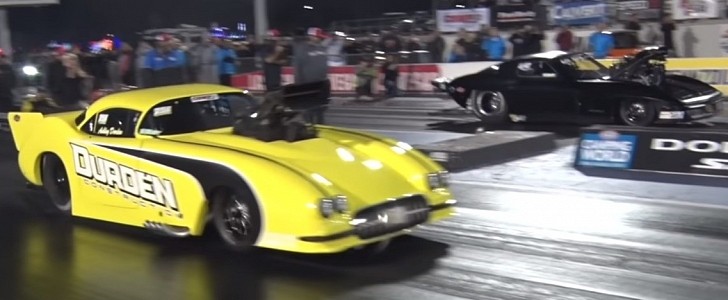California-resident John Durden has been drag racing since 1990. He has worked with the same tuner since then, and their first competitive car was a 2002 Chevrolet S10 that ran in the Pros Stock class. For a few years now, John has been racing a 1959 Corvette in the Promod class, and they are fast.
Despite having the apparent body of a 1959 Corvette, the V8-powered drag car has a Jeffers chassis and comes with four-figure horsepower. In late 2015, the supercharged V8 produced approximately 3,500 horsepower, which went to the rear wheels through a three-speed Lenco drive transmission.
As you will observe in the video below, John Durden still uses the three-speed transmission, while traction is provided by a Mark Williams 9.5-inch rear-end and a set of Hoosier drag tires. With four-figure power levels, this Corvette is impressive regardless of what vehicle it faces on the drag strip.
The engine is a 526-cui (ca. 8.6-liter) big-block V8 with a screw-type blower. The power plant was assembled by Miner Brothers Racing. Despite running mid-five-second quarter-mile times, John still prefers shifting gears himself. In the interview with 1320video, he explained that it provides "a little more excitement." You might say that is an understatement if you watch the videos from the cockpit.
Per class regulations, this 1959 Corvette weighs 2,600 lbs. (1,179 kg). There is nothing stock left on this vehicle, but it still manages to retain the iconic shape of the windshield, the dual headlights, as well as the roof and the rear pillar.
With four-figure horsepower on tap, traction is an issue, and the driver must “paddle” the throttle. If you are not familiar with the term, it means continuous adjustments to the gas pedal while accelerating, and it is all done in milliseconds. You have to admire the level of skill that is required to pull this off time and time again.
Failing to manage traction in a situation like this may lead to a crash, so each drag racing competitor has good reason to pay attention to this aspect. While some say there is no replacement for displacement, there is also no replacement for experience, either. The result of the above is a five-second quarter-mile time with an exit speed of 250 mph (ca. 402 kph), but it has done even better.
As you will observe in the video below, John Durden still uses the three-speed transmission, while traction is provided by a Mark Williams 9.5-inch rear-end and a set of Hoosier drag tires. With four-figure power levels, this Corvette is impressive regardless of what vehicle it faces on the drag strip.
The engine is a 526-cui (ca. 8.6-liter) big-block V8 with a screw-type blower. The power plant was assembled by Miner Brothers Racing. Despite running mid-five-second quarter-mile times, John still prefers shifting gears himself. In the interview with 1320video, he explained that it provides "a little more excitement." You might say that is an understatement if you watch the videos from the cockpit.
Per class regulations, this 1959 Corvette weighs 2,600 lbs. (1,179 kg). There is nothing stock left on this vehicle, but it still manages to retain the iconic shape of the windshield, the dual headlights, as well as the roof and the rear pillar.
With four-figure horsepower on tap, traction is an issue, and the driver must “paddle” the throttle. If you are not familiar with the term, it means continuous adjustments to the gas pedal while accelerating, and it is all done in milliseconds. You have to admire the level of skill that is required to pull this off time and time again.
Failing to manage traction in a situation like this may lead to a crash, so each drag racing competitor has good reason to pay attention to this aspect. While some say there is no replacement for displacement, there is also no replacement for experience, either. The result of the above is a five-second quarter-mile time with an exit speed of 250 mph (ca. 402 kph), but it has done even better.







